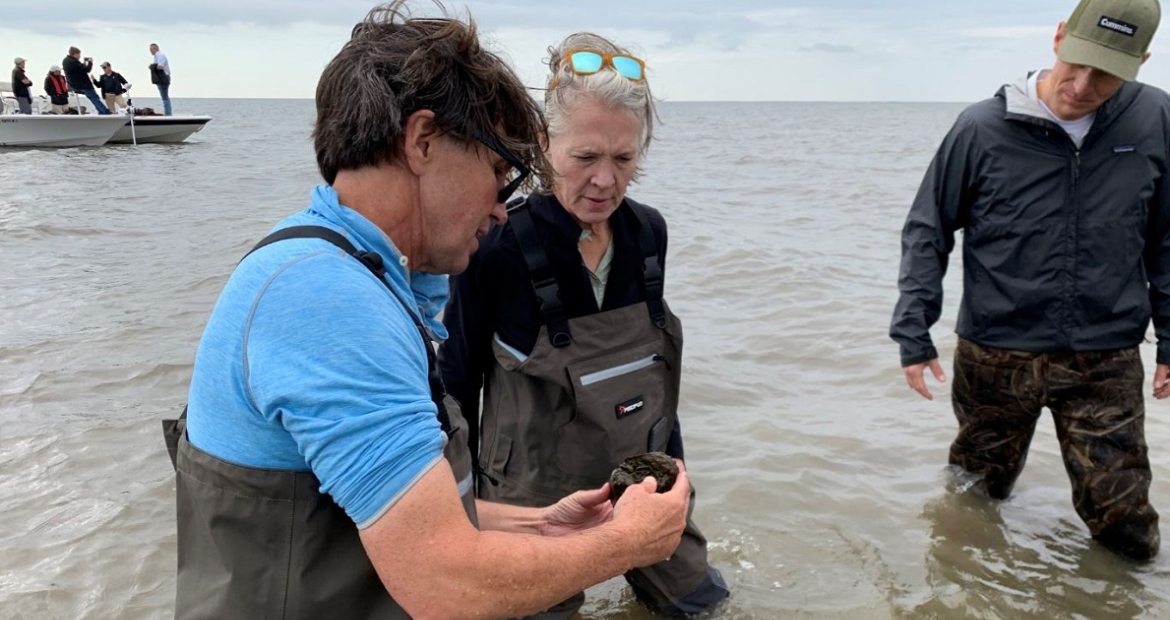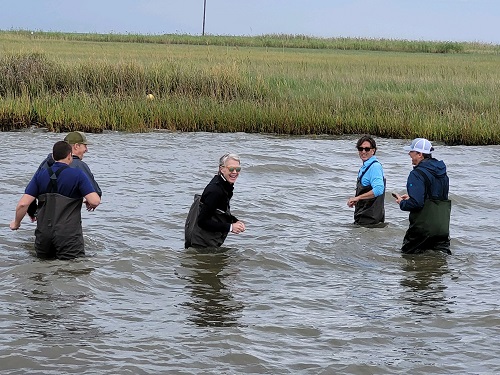Putting oyster power to work to help save the U.S. Gulf Coast
Corporate Responsibility Director Travis Meek was aware of oysters’ amazing ability to filter out pollutants when he visited a company-supported oyster reef project in Louisiana earlier this month.

Meek says until he saw it first-hand, however, he didn’t fully appreciate the other environmental benefits from The Nature Conservancy’s three-mile oyster reef restoration project underway along the Sabine National Wildlife Refuge in Calcasieu Lake.
"I wasn’t as well informed about the benefits they provide with respect to controlling erosion along the coast,” said Meek, who oversees Cummins Water Works and visited the project along with six other Cummins leaders Nov. 3.
“Louisiana is losing shoreline at a rate of 75 square kilometers per year, which is faster than anywhere on earth,” he said. “While the reefs are only one of many needed solutions, they significantly slow the rate of erosion where they’ve been built.”

CREATING SUSTAINABLE WATER SUPPLIES
Cummins Water Works is the company initiative to address the global water crisis by partnering with leading water experts and investing and engaging in sustainable, large scale, high impact water projects. Earlier this year, Cummins Water Works announced a $3 million, multi-year grant to The Nature Conservancy to restore water resources in the Mississippi River Basin in the United States.
The Nature Conservancy’s effort is focused both on the upper and lower reaches of the basin. The Wabash River watershed, which includes Cummins’ headquarters in Columbus, Indiana, is the single largest contributor of excess nutrients such as nitrogen and phosphorous from fertilizer to the Mississippi River Basin.
These excess nutrients not only pollute drinking water systems in the Midwest, but also contribute to an extensive dead zone, roughly the size of Massachusetts, in the Gulf of Mexico along the Louisiana-Texas coastline. The pollutants choke marine life, jeopardize the region’s fisheries and hamper recreation and tourism.
The project is working with farmers in the Midwest on the benefits of adopting more sustainable farming practices like cover crops during the winter and no-till farming to reduce the runoff of excess nutrients. A team of Cummins employees recently worked with The Nature Conservancy to reintroduce mussels in parts of the upper watershed to clean and filter water before it reaches the gulf.
NATURE’S FILTERING SYSTEM
Oyster reefs do much the same thing, serving as one of nature’s most efficient filtration systems, according to Seth Blitch, The Nature Conservancy’s Conservation Director in Louisiana. Blitch led the Cummins’ team on their tour of the project.
He said a healthy, one-acre reef can filter approximately 24 million gallons of water each day. Oyster reefs can also serve as natural buffers against rising sea levels from climate change as well as storm events.
The reefs form living shorelines that protect the adjacent coastal wetlands by dampening wave energy that would otherwise cause erosion. They also provide a critical habitat for marine life, contributing to the economic success of fisheries in the gulf.
The Nature Conservancy has so far restored over seven miles of oyster reefs, establishing an impressive coalition behind the work, which started in 2010. Supporters include the Louisiana Department of Wildlife and Fisheries, adjacent landowners and private donors and corporations contributing money to the effort.
Phase III of the project, which extends the reef for about a mile, was constructed in July and August. Blitch said The Nature Conservancy was able to significantly expand the scope of its original plan with Cummins’ support.
LEADERS LEAVE IMPRESSED
Cummins’ leaders making the trip included Vice Chairman Tony Satterthwaite and Mary Chandler, Vice President – Community Relations and Corporate Responsibility. After a short boat ride, the leaders put on waders and made their way through knee-high water to observe the reefs up close.
The reefs are constructed using wire baskets called gabions filled with limestone placed close to the shoreline to ensure the bulk of any erosion from wave action doesn’t get far. The baskets are tall enough so the reef that forms can’t be buried by sediment.
Over time, oysters cluster on the baskets and fuse together, creating rock-like reefs that provide habitat for other marine life. The oysters in the project are protected by law and cannot be harvested.
“I was really surprised by how quickly new reefs can be implemented,” said Zach Gillen, General Manager – Cummins Sales and Service North America. “Large reef extensions can take place in less than a year and they are definitely making a difference.”
Brian Mormino, Cummins’ Executive Director – Technical & Environmental Systems, said the trip left him with a renewed appreciation for the knowledge and dedication of The Nature Conservancy, and the complexity of the challenge moving forward.
The effort has stakeholders extending some 800 miles from north to south in occupations ranging from farming to shipping and commercial fishing. The initiative is further complicated by flooding to the north and hurricanes to the south.
“It’s one thing to know about a challenge and another to see it,” Mormino said. “I think the trip strengthened our commitment to what we’re doing, and our desire to do more.”